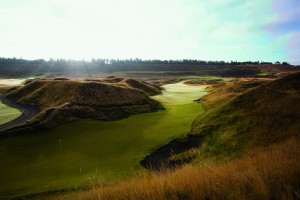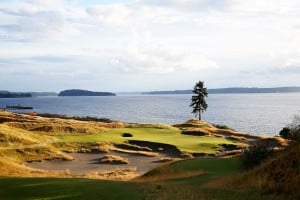Chambers Bay is unknown by most, unproven to many, and undeniably a strange concoction. Why is it positioned to set so many US Open records? The players have yet to tee off, but the 2015 US Open, the first in America’s Pacific Northwest, is already making history. A decade ago the course, as improbable and unconventional as they come, didn’t exist. Now it’s hosting the US Open? Inconceivable. ▶ If it hasn’t happened before in an Open, it’s probably happening June 19-22 at Chambers Bay.
(1) It’s the first US Open to be contested in a sand box
Chambers Bay lies in an old sand and gravel pit on the western edge of the Tacoma, Washington, suburb of University Place. It’s a tilted bowl, open on the west, with railroad tracks and gorgeous Puget Sound beyond.
To the east is a high, long cliff. Atop its rim is Grandview Drive, where rubberneckers can stand with binoculars and scout for Rory, Phil & Co. some 80 feet below.
The pit was first mined in the 1890s, and over the next century it’s said to have provided 90 percent of the material used to create the skyline of Seattle, 40 miles north. Lucky for golfers, it was mostly gravel – not sand – that was removed.
After the Pierce County wastewater district bought the 900-acre site in 1992, mining continued until 2001, after a pit-bull prosecutor named John Ladenburg was elected as the chief county executive and decided the waterfront property should be redeveloped for public recreation, including ball fields, hiking trails and a golf course.
(2) It’s the first course designed specifically to host a US Open
In January 2004, Ladenburg and an advisory committee interviewed five finalists. They were Robert Trent Jones II (a firm consisting of partners Robert Trent Jones Jr and Bruce Charlton); Hurdzan/Fry Design, at the time creating Erin Hills, which will be the Open site in 2017; Bob Cupp, who designed the 36 holes at Pumpkin Ridge near Portland, long considered a front-runner for an Open; Phil Mickelson, at that point yet to win a Major; and local favourite John Harbottle III.
Ladenburg notified each firm that a US Open was his goal, and that he wanted a links-like course. So each of the five proposals envisioned a British Open-like layout. The recommendations of the advisory committee were not unanimous. Ladenburg, who had the final say, selected the Trent Jones firm.
What was the determining factor? It was not, as has been widely reported, that the Jones team concluded by handing each committee member a metal bag tag, embossed with the Pierce County logo and the words “Chambers Creek” (the working title of the project at the time) and “US Open 2030.”
“That was a cute gesture, but it wasn’t a factor,” Ladenburg says. “Besides, they got it wrong by 15 years.”
What swayed Ladenburg was the vast global experience of Trent Jones Jr. He’d done links designs before, in California and abroad. None of the others had.

(3) It’s the first Robert Trent Jones Jr design to host a US Open
Hard to believe that in a hugely successful career of over 50 years, with 300-plus designs and redesigns to his credit, Trent Jr. (or Bobby, as most call him), never had a course that even sniffed a U.S. Open. For Bobby, 75, this Open is a lifetime achievement award of sorts.
But like Amish barns and children everywhere, it takes a village to raise a golf course, and Bobby is generous in sharing credit for the collaborative design. “Everything was debated,” he says. “Constantly. Sometimes with great passion.”
Equally hard to believe is that Chambers Bay is a Trent Jones Jr. design. It bears no resemblance to anything he has previously produced. Chambers Bay is ragged, jagged, rustic and unkempt, seemingly unfinished in some corners and purposefully quirky in others.
(4) It’s the first all-fescue US Open course
The fescue turf, ideal in a maritime climate, is common on the links of Scotland, Ireland and the English coastline, but not on courses in America.
Today, everything could be mowed at greens height if desired. For the Open, the highly contoured greens will be mowed at .18 inches, which will translate to a Stimpmeter reading of 12, and there will be noticeable grain. There will be a belt of fescue rough at about three to four inches (narrowing some of the widest fairways to 30 or 40 metres), then taller stuff farther out.
Adds Bobby: “When a ball lands, it won’t be clear when or where it’s going to stop.”
(5) It’s the youngest course to be awarded the US Open
Chambers Bay opened for play on June 23, 2007. Less than eight months later, on February 7, 2008, the USGA announced it was awarding the 2010 US Amateur and the 2015 US Open to the place. The selection was helped considerably when Congressional, under contract for the 2010 Amateur, begged off because of pending greens reconstruction, and Winged Foot and Shinnecock declined to pursue the 2015 Open.
The timing of the Chambers Bay announcement was dictated by law. As a county-owned golf course (incidentally, the first county-owned course to host a US Open), it had to immediately disclose its contracts to the public.
The timing was fortuitous. The economic recession had already hit the area. Chambers Bay was not meeting expectations or expenses, and there was grumbling that Ladenburg had wasted $22 million on the course.
“The USGA, by its announcement, saved the golf course,” Jones says. Without that, and some funds that the USGA later advanced, “I don’t think Chambers Bay would be here today. It would have been a hard political fight to keep it. You don’t cut firemen’s pay but keep running a golf course.”
After the announcement, Chambers Bay steadily became a national golf destination, if not a money-maker. Last year, it showed a profit for the first time.
(6) It’s the first US Open course to have holes that will alternate par
For the Open, Davis will convert the fourth, normally a par 5, into a par 4, so the course will play as a par 70. “It’s a much more interesting drive zone when you move the tee up,” he says.
Total yardage will vary every day. The maximum length is 7,260 metres, but for the Open, yardage will range from 6,580 to 7,100, depending on weather, wind conditions and tee and hole locations.
For a time, Davis toyed with the idea of playing the course as a par 71 on certain days and par 70 for other rounds because he was undecided on whether to play the first and 18th holes as long par 5s each day (par 71), or one of them as a par 4 (par 70). Then it occurred to him, because the two holes are parallel in opposite directions, he could alternate the par each day and still retain the overall par of 70.
“When we play the first hole as a par 4, 18 will be a par 5, and vice versa,” Davis says. “Both holes are so neat architecturally, both as par 4s and par 5s. It speaks volumes for the incredible flexibility of the design.”
(7) This will be the first US Open televised by Fox Sports Network
With only one previous golf broadcast, Fox is as untested as Chambers Bay. Producer Mark Loomis has plenty of experience, having done golf for ABC and ESPN, but on-air co-hosts Greg Norman and Joe Buck and are rookies, as is tower announcer Brad Faxon. Steve Flesch, Scott McCarron, Juli Inkster, Corey Pavin, Shane O’Donoghue and Holly Sonders have done golf commentary, but nothing on this scale.
Fox promises to explore “new avenues” including drone camera views (at far lower angles than helicopter views) and even some drone shots following players at a discreet distance. The USGA isn’t comfortable with microphones on caddies, but long-range mics will eavesdrop on the discussions between players and caddies.
Fox also plans 3-D effects to show the extreme contours.

(8) Chambers Bay is the first US Open course with only one tree
It’s not that Chambers Bay was treeless to begin with, but the only mature tree was a solitary, wind-warped fir near what became the 16th tee. The designers decided to keep it. The tree was vandalised in 2008 when someone hacked it with an axe, but it recovered and is the background for the wedding photos of project architect Jay Blasi, who married his wife, Amy – whom he’d met on the job – on the 15th tee before the 2010 Amateur.
(9) In a story of firsts, we finish with a last: Chambers Bay will be the last US Open where an anchored putting stroke will be allowed
The ban goes into effect on January 1, 2016. Come on, Scotty!




